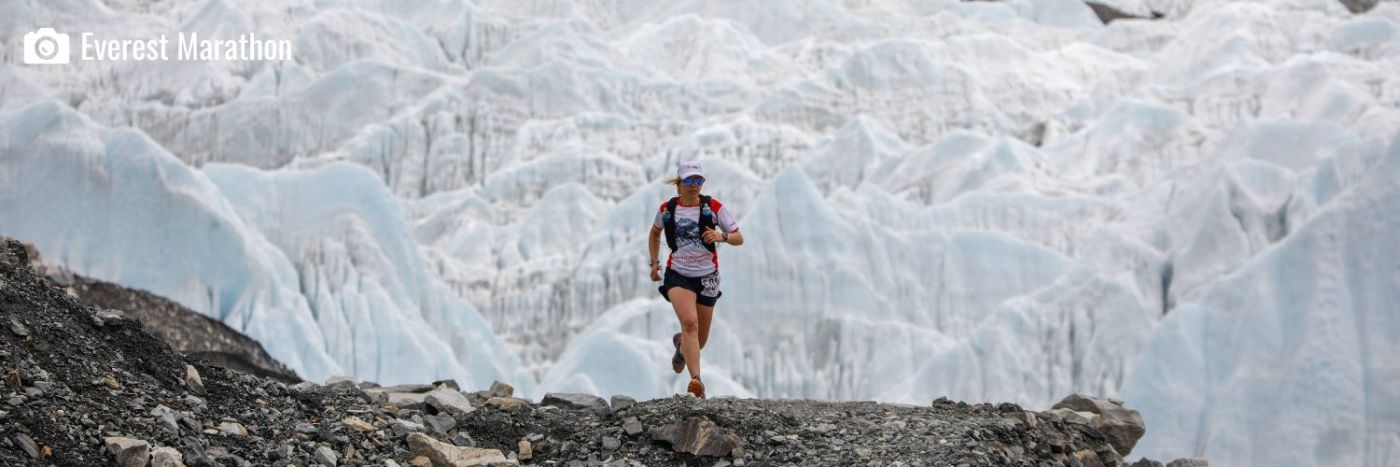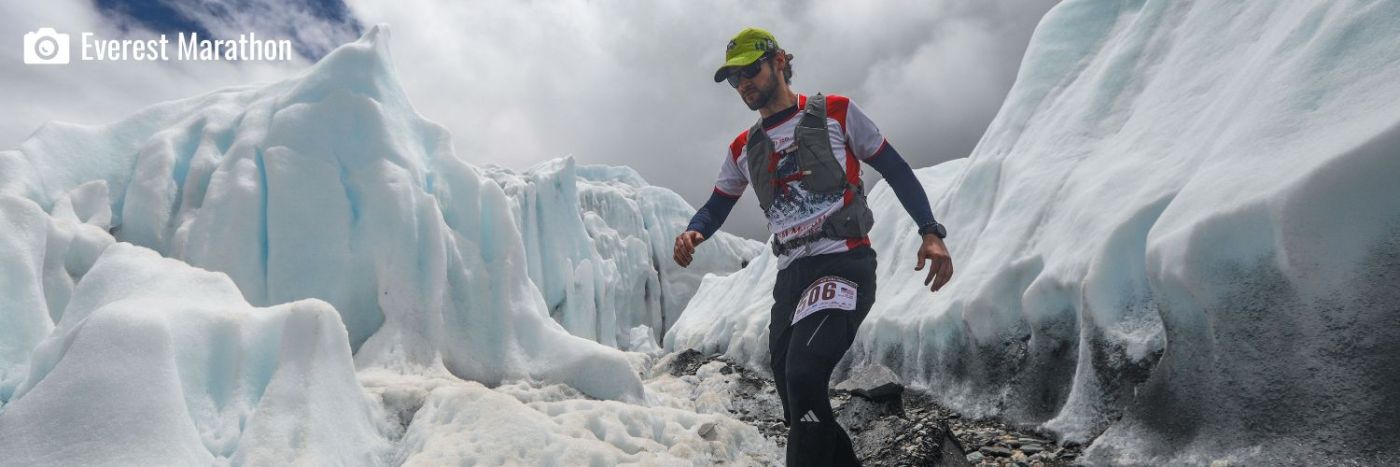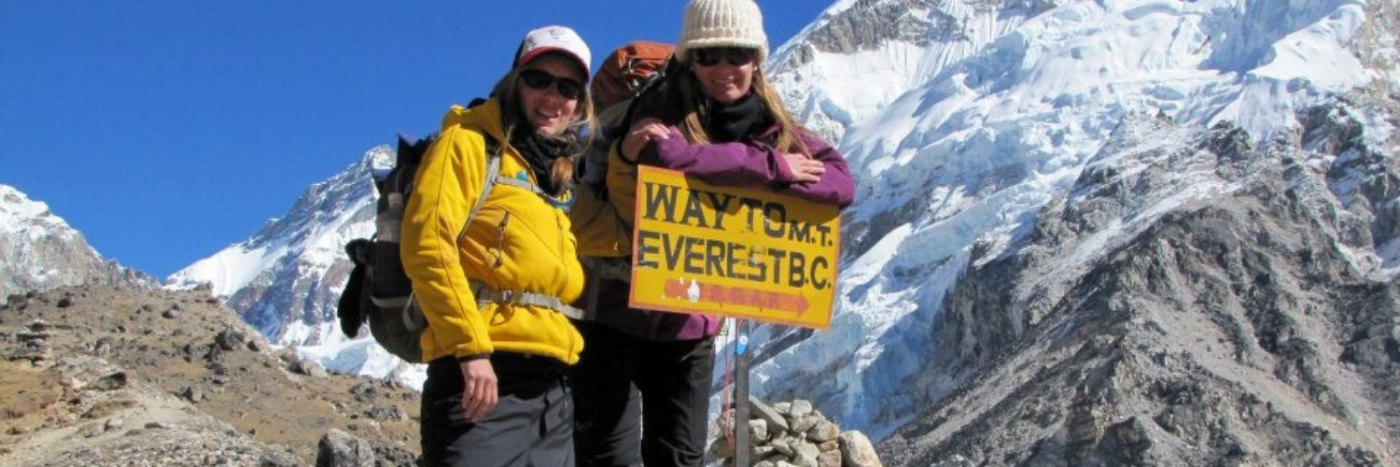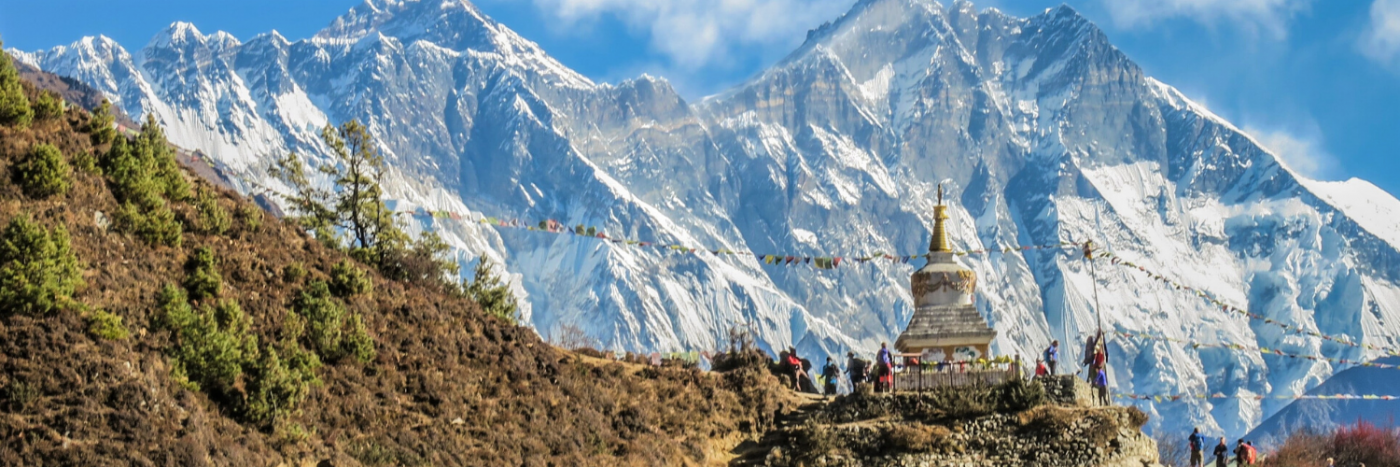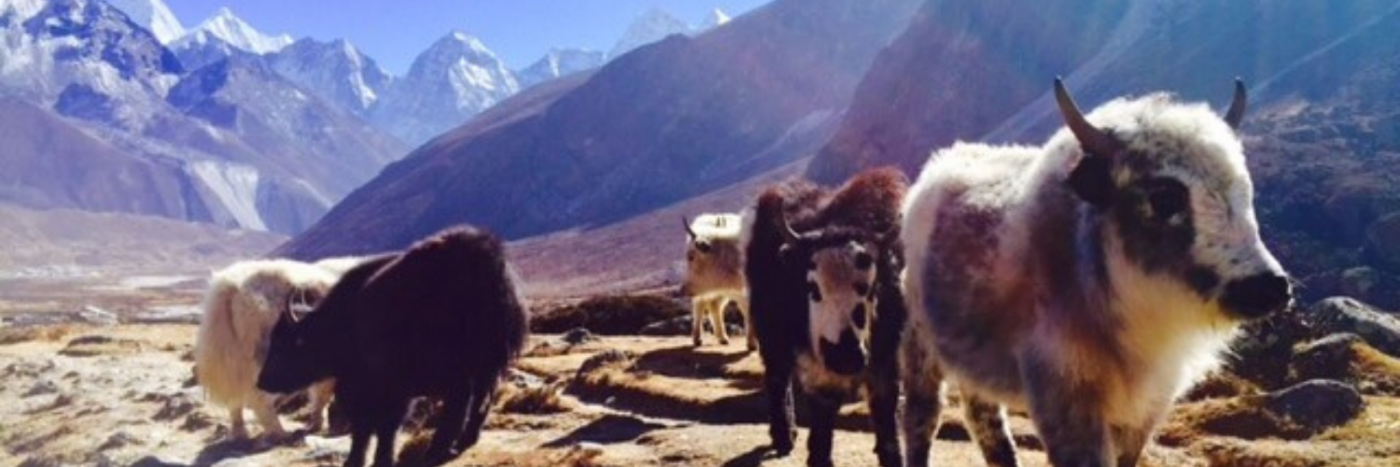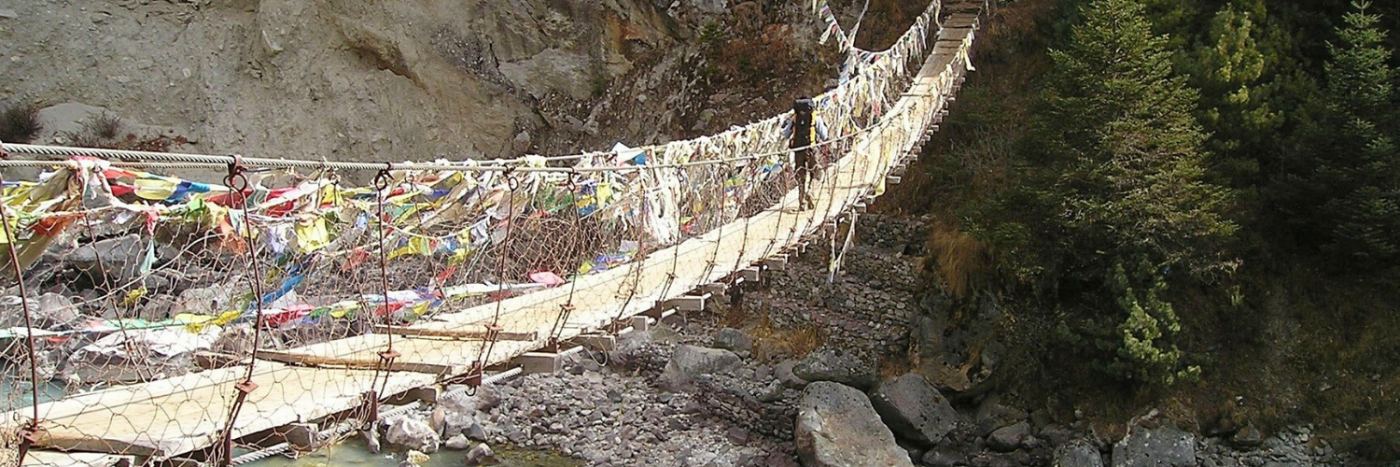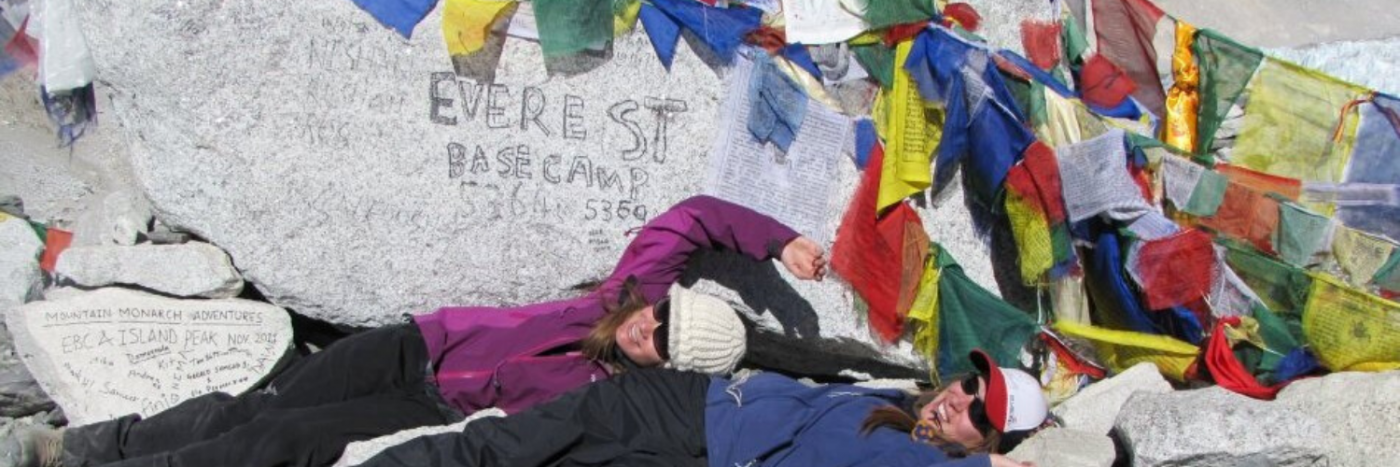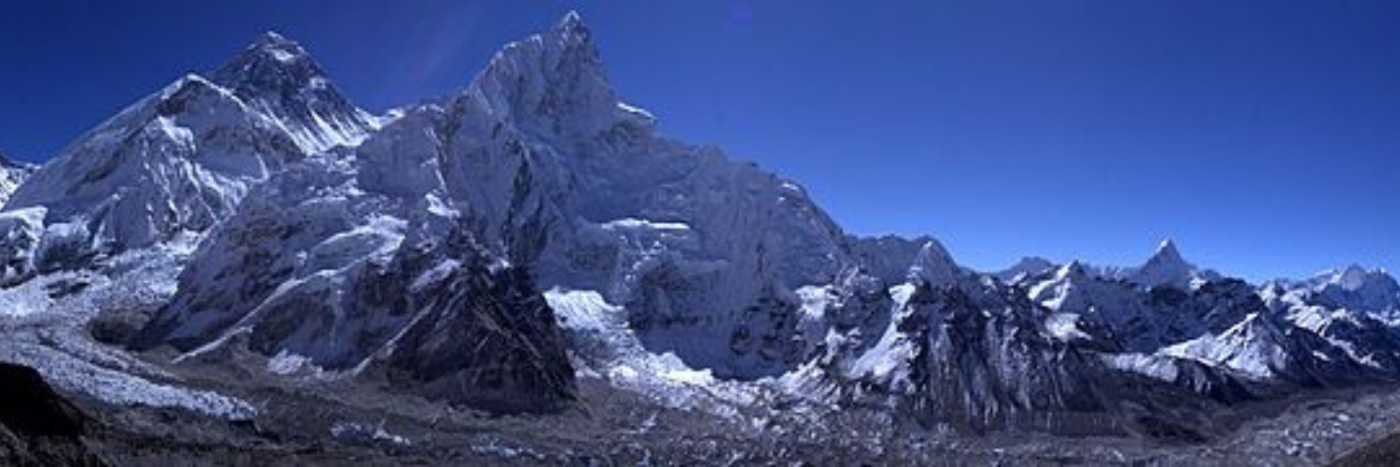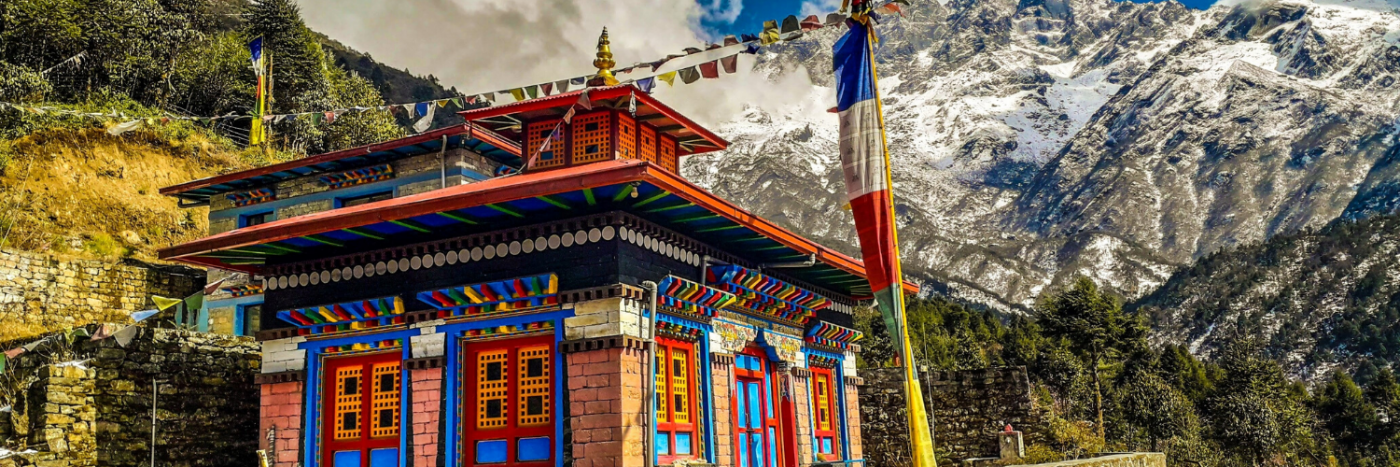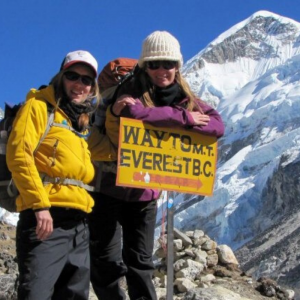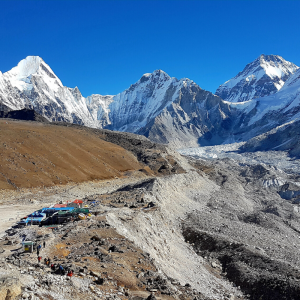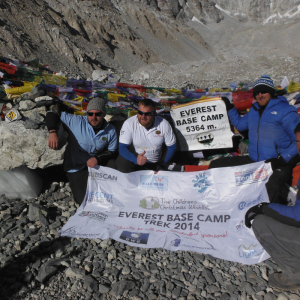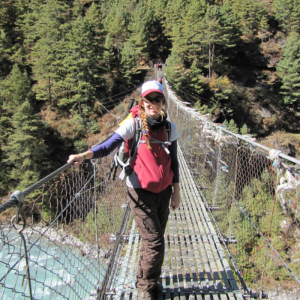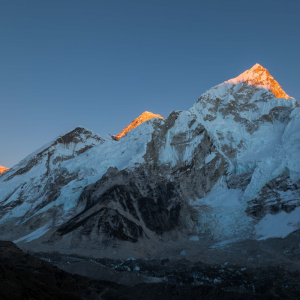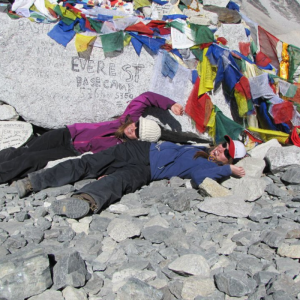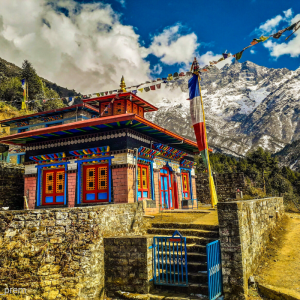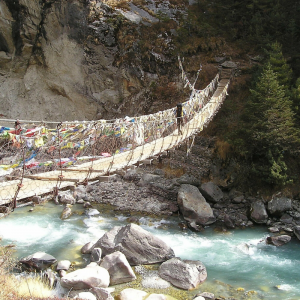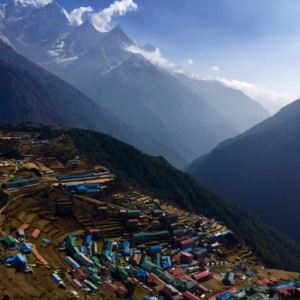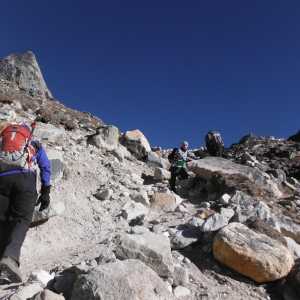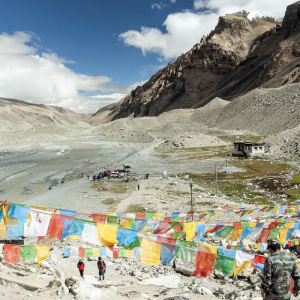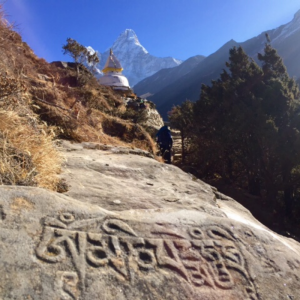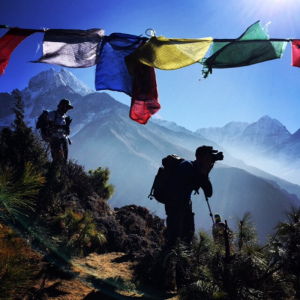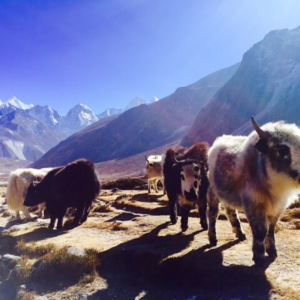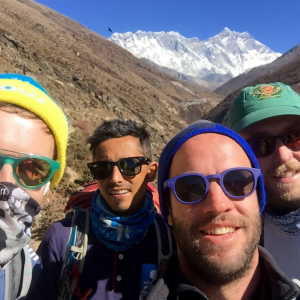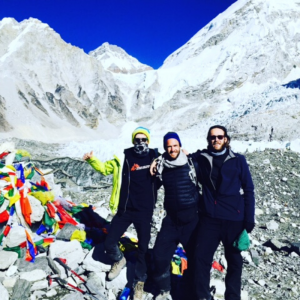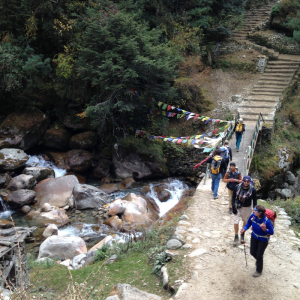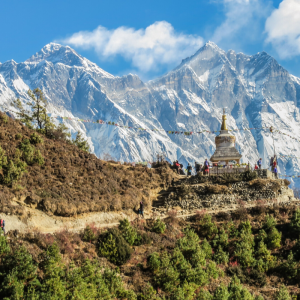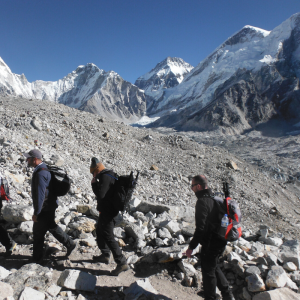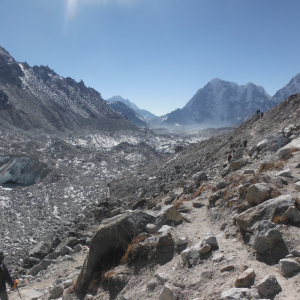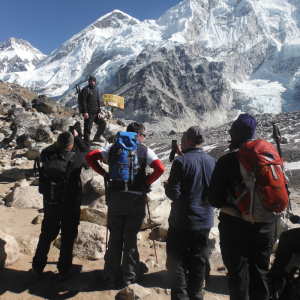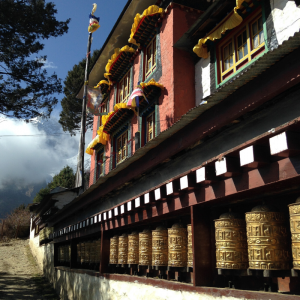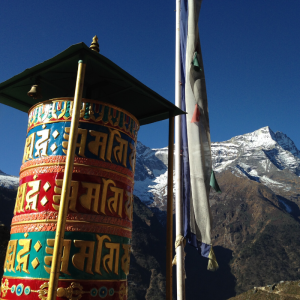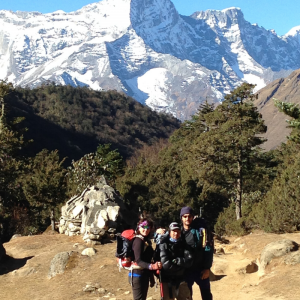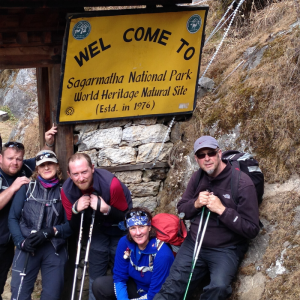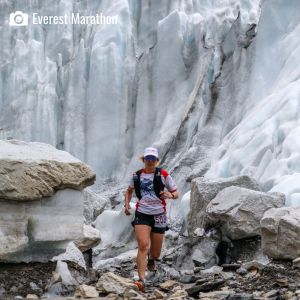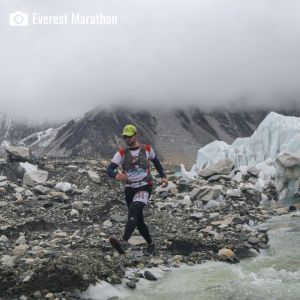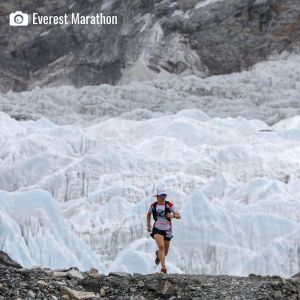- Overview
- Map & Itinerary
- Essential Info
- Pics & Vids
- Dates & Prices
Highlights
- Join Everest Summiteer, Jo Bradshaw, to celebrate the 10th anniversary of her Everest summit success
- Run the highest marathon in the world marking the historic ascent by Tenzing Norgay Sherpa & Sir Edmund Hillary
- Maximise your marathon acclimatisation with our carefully crafted itinerary
- Experience the warmth of the Sherpa people, their rich culture, and their unparalleled hospitality
- Trek only package available for family and friends to be part of your marathon experience
- Receive a free Adventurous Ewe Water-To-Go Bottle on departure to reduce our plastic footprint in Nepal.
Overview
Everest Double – The Ultimate Trek & Marathon Challenge
If you’re ever going to run the world’s highest marathon, this is the year to do it – with the inspirational Everest Summiteer, Jo Bradshaw, celebrating the 10th anniversary of her own Everest summit success.
This is more than a race; it’s a once-in-a-lifetime adventure. Your journey begins with a carefully crafted trek to Everest Base Camp (5,364m), giving you the best possible acclimatisation for race day. Along the way, you’ll be immersed in the rich culture and legendary hospitality of the Sherpa people, gaining a deeper connection to the mountains that have inspired trekkers for generations.
Then comes the run of a lifetime – the Tenzing-Hillary Everest Marathon. First run in 2003, this world famous marathon pays tribute to the historic first Everest ascent by Tenzing Norgay Sherpa and Sir Edmund Hillary. The course takes you from Base Camp to Namche Bazaar (3,446m), weaving through rugged trails, glacial moraines, and breathtaking Himalayan landscapes. With one last push to the end the final 500m ascent from Phunki Tenga to Kunde is a true test of endurance before the descent into Namche.
On race day, there will be an official timekeeper, marshals, regular checkpoints with water & food, as well as medical and emergency evacuation support. Although the course is predominantly downhill, it presents a significant challenge with snow and ice at higher altitudes, as well as rocky and exposed sections along the trail. This marathon is best suited for runners with experience in cross-country, trail, fell, or mountain racing. Friends and family members are welcome to join the trek part of the adventure and accompany runners as non-running participants.
This is your chance to push your limits, embrace adventure, and be part of something truly special amidst one of the most magnificent mountain regions in the world.
Flights
Flights are not included in your Everest Double adventure giving you the flexibility to depart from the airport of your choice and extend your stay Nepal if you wish.
We will provide you with the recommended flights for this trip in order for you to take up the airport transfers included in Nepal. Alternately, you can book your flights through our flight agent who is ATOL & ABTA protected.
Arrive and pre-trip briefing
A warm Nepalese greeting is awaiting you on your arrival at Kathmandu Airport where you will be transferred to your hotel in Thamel.
Your Local Guide will also provide you with a comprehensive trek briefing so you’re all set for your exciting mountain adventure ahead.
Included
Transfer: For designated flight arrival time. You will be met at the airport and transferred to your hotel in Thamel, Kathmandu. For those of you who are not on or near this flight, you will simply catch a taxi to the hotel.
Accommodation: Hotel (twin share basis)
Meals: Not included
Morning tour of Kathmandu. Afternoon transfer to Mulkot
The day starts with a visit to one of the holiest temples for Hindus all around the world – Pashupatinath. Your local guide will take you through the spiritual journey with an engrossing explanation about the Hindu religion, the cycle of birth and death and the story behind the Sadhus – Hindu Holy Men, who renounce their social life to devote their life to Shiva (Hindu God of Destruction) to whom the temple is dedicated. Spiritually stimulated, you’ll travel a short distance (15min approx) to reach the largest Buddhist stupa in Nepal (disputably, in the world) – Bodhnath. Follow the pilgrims circumambulating the stupa spinning the prayer wheels. Offer your prayers to Lord Buddha lighting a traditional butter lamp at the main entry way to the stupa. Lunch at a roof-top restaurant commanding an enticing view of the stupa.
After lunch, drive south-west out of Kathmandu for approx 85 kms to Sun Koshi valley for a night in Taj River-view Resort located near to Sun Koshi river in the village of Mulkot along Banepa-Sindhuli-Bardibas highway. Transfer to Mulkot (3.5 – 4 hrs approx).
Included
Transfer: Private transfer
Accommodation: Taj Riverside Resort or similar (twin share basis)
Meals: Breakfast & dinner
Spectacular flight to Lukla (2800m); trek to Phakding (2,652m)
Following breakfast you will be transferred to Manthali Airport (1 – 1.5 hr approx) for your flight to Lukla (approx. 20 mins). During the flight if the weather is good, the views of the Himalayas from the small plane are amazing as you enter the gateway to the region of the legendary Sherpas.
Landing on the mountain airstrip of Lukla (2,800m), your trek begins heading northwards up the valley of the Dudh Kosi (or ‘milk river’). The route then descends from the small plateau, down into the forested valley. Heading north towards Phakding – meandering trails lined with stoned walls. Lunch en route in a picturesque Thado-Koshi on the high rise above the river of the same name and with imposing sister peaks of Kusum-Kangarru in the backdrop. The trail offers some tantalising views before reaching the small settlement of Phakding (2,800m), where you will spend your first night in a basic teahouse.
Trek details
Trek length: approx. 9kms
Trek time: approx. 3 hours
Total ascent: 190m
Included
Transfer: Airport transfer
Accommodation: Teahouse at 2800m
Meals: Breakfast, lunch & dinner
Trek from Phakding to Namche Bazaar (o/n at 3440m), with time to explore the Sherpa villages
Heading out of Phakding your route follows the Dudh Kosi northwards. Today’s walk takes you through magnificent forests with glimpses of the mountains ahead. Crossing the river several times by bridges you will pass through the villages of Benkar, Monzo and Jorsale. A final bridge spanning the narrow gorge of the river Dudh Koshi brings you to the foot of the steep climb to Namche. Halfway up this ascent, you may get your first glimpse, cloud-permitting, of the summit of Everest appearing majestically behind the great ridge of Nuptse-Lhotse. A last 300m of climbing brings you to Namche Bazaar, the Sherpa capital and the main town in the area. At an elevation of 3450m above the sea level, Namche Bazaar is the largest village in the Everest region often called the ‘Sherpa Capital’ of Khumbu and is an important trading centre. It has a weekly market on Friday afternoon and Saturday mornings but the town bustle and buzz all day every day with trekkers, coffee shops, bakeries and stores selling all kinds of trekking and climbing gear as well as Tibetan artifacts.
Trek details
Trek length: approx. 11kms
Trek time: approx. 6 hours
Total ascent: 830m
Included
Accommodation: Teahouse at 3440m
Meals: Breakfast, lunch & dinner
Acclimatisation day Namche Bazaar to Khumjung (3780m)
Namche Bazaar is tucked away between two ridges amongst the giant peaks of the Khumbu. An ancient marketplace where goods from as far away as Tibet are still are traded. Namche is a great place to spend an acclimatisation day before trekking higher with its abundance of cafes, bars and souvenir shops. Today will see you take an acclimatisation walk, whether this involves going as high as the village of Khumjung (3780m) above Namche, or to the Everest View Hotel. Either of these options provides superb views of Ama Dablam, Nuptse, Lhotse and Everest. You will then spend a second night at your teahouse in Namche Bazaar.
Trek details
Trek length: approx. 9kms
Trek time: approx. 4 hours
Total ascent: 380m
Included
Accommodation: Teahouse at 3440m
Meals: Breakfast, lunch & dinner
Trek Namche Bazaar to Tengboche (o/n at 3860m)
Today’s trail is spectacular in terms of scenery. The main route out of Namche heads north-west climbing steeply out of the town to a ridge crest where a spectacular view of Everest, Lhotse and Ama Dablam is revealed. The trail then follows a contour high above the river with occasional short climbs as you cross a series of ridges. Towards the end of this contour trail is the tiny settlement of Kangjuma where various items of local art and craft are laid out to entice passing trekkers.
From Kangjuma the trail descends to a bridge across the Imja River at Phunki. Beyond the river, you’ll climb a long ridge to Tengboche (3860m) the halfway point of your trek and the location of one of Nepal’s finest monasteries. Tengboche Monastery, also known as Dawa Choling Gompa, is a Tibetan Buddhist monastery of the Sherpa community. Situated at 3,867 metres, the monastery is the largest gompa in the Khumbu region of which you’ll have the chance to visit.
The sunset and sunrise on the fantastic panorama of mountains surrounding us are not to be missed – Everest, Nuptse, Lhotse and Ama Dablam provide a wonderful backdrop to your teahouse. Look out for Himalayan Tahr in the forest surrounding the monastery.
In the evening, you can visit the much-revered monastery for an interaction with the
resident monks and to attend a prayer session and get the blessing from a monk, as do all the climbers on the Everest expeditions.
Trek details
Trek length: approx. 11kms
Trek time: approx. 6 – 7 hours
Total ascent: 420m
Included
Accommodation: Teahouse at 3860m
Meals: Breakfast, lunch & dinner
Trek Tengboche to Dingboche (o/n at 4400m)
Today will see you descend through the forest to Devoche before crossing the rushing Imja Khola, whose valley the route will then follow. Climbing steadily, the trail enters Pangboche, at 3900m, the highest and the last settlement that is inhabited all year round. Ascending the valley, you will have lunch at Shomore, after which you will leave the trees behind and cross a wooden bridge at the confluence of the Khumbu and Imja Kholas. A short steep climb brings you to Dingboche, at 4400m, a summer settlement where you will be surrounded by towering peaks.
Trek details
Trek length: approx. 12kms
Trek time: approx. 6 hours
Total ascent: 480m
Included
Accommodation: Teahouse at 4400m
Meals: Breakfast, lunch & dinner
Acclimatisation day in Dingboche to Chukkung (4730m)
In accordance with our careful program of acclimatisation you will spend 2 nights at this altitude before moving further up the Khumbu Valley. To assist with your acclimatisation you will have a day hike to Chukkung (4730m) in the upper part of the Imja Valley and directly below the tremendous 3000 metre south face of Lhotse. This is a high and wild corner of the Khumbu, the views here of ice flutings and soaring, serrated mountain ridges are incredible. After a most scenic lunch stop, you will retrace your steps to Dingboche to spend a second night in your teahouse. There are fantastic views towards Tibet and of Island Peak and Ama Dablam.
Trek details
Trek length: approx. 10kms
Trek time: approx. 5 hours
Total ascent: 380m
Included
Accommodation: Teahouse at 4400m
Meals: Breakfast, lunch & dinner
Trek from Dingboche to Lobuje (4,910m)
The trail climbs steeply out of Dingboche past a chorten and ascends the valley gradually to Dugla at the end of the terminal moraine of the Khumbu Glacier. A steep climb to Chukpo Lari, a striking yet poignant place with a cluster of memorials in tribute to the climbers who have died on Everest together with panoramic views of the peaks lying on the Nepal-Tibet border. The trail then eases off as you follow the valley to Lobuje, a tiny hamlet with a few teahouses occupying a rocky, streamside location surrounded by towering peaks including Pumori (7161m), Nuptse (7861m) and Lhotse (8516m). The sunset over Nuptse is something not to be missed.
Trek details
Trek length: approx. 12.1kms
Trek time: approx. 6 hours
Included
Accommodation: Teahouse at 4910m
Meals: Breakfast, lunch & dinner
Trek Everest Base Camp (5364m) and Gorakshep (5080m)
Today is a long day as you leave very early and follow the Khumbu Glacier northwards to Gorakshep (5,184m). The trail undulates up and down the moraine with some short steep sections. The path is rocky as you are now on the lateral moraine of the Khumbu Glacier. It will take approximately 3 hours to reach Gorakshep teahouse where you can unload your bags, restock your snacks and water to then make your final approach to Everest Base Camp. The trail ascends the side of the glacier for a couple of hours before finally descending onto the rocky glacial moraine itself. The route winds through fascinating ice seracs to the area known as Everest Base Camp. From Base Camp (5364m) you will have close up views of the Khumbu Ice Fall where you can appreciate just how difficult it is for the climbers to negotiate a route through this area on their Everest ascent. Here Nuptse towers above and Pumori rears up behind and you are left in awe of this incredible location. After the obligatory photo stop at Base Camp you will retrace your steps back to Gorakshep.
Trek details
Trek time: approx. 9 hours
Total ascent: 274m
Included
Accommodation: Teahouse at 5080m
Meals: Breakfast, lunch & dinner
Trek Gorakshep to Pheriche (4280m) via Kalapathar (5,545m)
Today sees another tough challenge with a non-technical yet steep climb above Gorakshep to the small prominent peak of Kalapathar, ‘Black Rock’, at 5545m in the early hours of the morning. From this lofty perch you will witness the grandeur of Everest up close with epic summit views of the world’s highest mountain and the neighbouring peaks of Nuptse, Lhotse and Ama Dablam.
Returning to Gorakshep (1.5hr approx) you’ll then proceed to Everest Base Camp to report to Race Organisers in preparation for your marathon.
Non-running group members will take a morning hike to Kalapathar before descending to Pheriche.
Please note, the walk to Everest Base Camp and the climb of Kalapathar are both very tough. We may change the order in which we tackle these sections depending on the group’s ability and weather conditions.
Trek details
Trek time: approx. 8 – 9 hours
Total ascent: 361m
Total descent: 1305m (trekking)
Included
Accommodation: Runners – Tented camp. Non-runners – Teahouse
Meals: Breakfast, lunch & dinner
Marathon Briefing, Mock Race and Medical Examination
Today sees your final day of preparation and acclimatisation at Everest Base Camp to ensure you are ready for the marathon challenge tomorrow.
Non-running group members will today trek from Pheriche to Namche Bazaar.
Included
Accommodation: Runners – Tented camp. Non-runners – Teahouse at 3440m
Meals: Breakfast, lunch & dinner
Everest Marathon Day – EBC to Namche Bazaar
Rise early and fuel up with breakfast as your epic race begins at 7:00am. As dawn breaks over the Himalayas, you’ll take your first strides from Everest Base Camp (5,364m) towards Namche Bazaar. The opening 5km across the Khumbu Glacier and back to Gorak Shep is the toughest underfoot, with uneven ice and rocky terrain testing your focus and agility.
Once you hit the famed Everest Trail, the path becomes more runnable, and by the time you reach Orsho at 21km, the extra oxygen at lower altitudes will have you feeling strong. But the real test lies ahead – a gruelling 500m climb from Phunki Tenga (34km) to Khunde, a final push before your victorious descent into Namche.
The world’s highest marathon concludes with a thrilling descent past the Hillary School and through Syangboche, before you finally cross the finishing line in Namche Bazaar. Meanwhile, non-runners will enjoy a well-earned rest day in Namche, soaking up the atmosphere as runners complete this iconic marathon challenge.
Runners – you personal baggage, carried by lightly loaded porters, will make its way back from Base Camp, arriving by the evening or early the next morning.
Included
Accommodation: Teahouse at 3440m
Meals: Breakfast, lunch & dinner
Trek from Namche Bazaar to Lukla (2800m)
This is the final day of your Everest trekking experience. A your route gradually descends, the valley becomes more enclosed passing through a variety of settlements and forests. After a stop for lunch, you’ll continue on the river’s true left bank to Chopling (2660m) where you begin the final climb of the trip with a 45-minute steady ascent into Lukla. Arriving at this bustling mountain town denotes that it’s your last evening of the trek giving you the perfect time to celebrate a successful journey and say thanks to the team, especially the porters who will return to their villages from here.
Included
Accommodation: Lodge at 2800m
Meals: Breakfast, lunch & dinner
Spare day for poor weather/acclimatisation
Day in hand for poor weather contingency or additional acclimatisation day. This day will also come into play if your flight to/from Lukla is postponed due to adverse weather conditions.
Included
Accommodation: Lodge at 2800m
Meals: Breakfast, lunch & dinner
Return flight from Lukla to Manthali (Ramechhap) and transfer to Kathmandu
Having completed one of the world’s most renowned mountain marathons or trails for the non-runners, it’s time to fly back Manthali (20 mins). A stunning morning flight over forests and villages where you’ll then be transferred to your hotel in Kathmandu (5 – 6 hours). Arriving in the bustling city late-afternoon, there’s time to freshen up before heading into town to enjoy the particular delights of Thamel. This evening you’ll enjoy a celebratory meal and reflect on your Everest Double adventure. Please note, dinner is at your own expense to allow you the freedom to order what you wish.
Included
Transfer: Private transfer
Accommodation: Kathmandu Guesthouse or similar (twin room share)
Meals: Breakfast only
Free day in Kathmandu (or can also be used as a spare day for any poor weather conditions)
You can either relax in the hotel or nearby cafes and watch the world go by in Nepal’s vibrant capital city or you can explore the rich in artistic and cultural heritage of Kathmandu full of fascinating and eclectic sights. Visit the Swayambhunath – the Monkey Temple; take stroll to Durbar Square – home to the Kumari Devi – considered a living goddess; pull up a seat in a cafe and enjoy a cup of spicy hot chai and watch the world go by or stroll through the backstreets and Kathmandu’s timeless cultural and artistic heritage reveals itself in hidden temples overflowing with marigolds, courtyards full of drying chillies and rice, and tiny workshops. The day is yours.
Alternately, you can join an optional tour of the medieval town of Bhaktapur (additional cost applies).
In the evening, attend the Everest Marathon celebration party!
Included
Accommodation: Kathmandu Guesthouse or similar (twin share basis)
Meals: Breakfast only
Return flight from Kathmandu home
Whether you’ve conquered the world’s highest marathon or trekked to Everest Base Camp, you’ll return home with a huge sense of achievement and stories to last a lifetime. After soaking in your final moments in the heart of the Himalayas, it’s time to bid farewell to this incredible adventure.
Transfers to Kathmandu Airport are provided for your onward journey. If you’d like to extend your stay in Nepal, why not add one of the trips below?
- Chitwan Safari
- Kathmandu to Delhi
- Ancient Varanasi & the Ganges
- Ancient City of Lhasa
Get in touch with us at info@adventurousewe.co.uk as we’d love to help you make the most of your Nepal experience.
Included
Transfer: From Hotel to Kathmandu Airport at designated time for nominated group flight
Meals: Breakfast only
Please note, this itinerary is subject to minor changes depending on flight times, weather (particularly with flying in and out of Lukla), the ability of the group, etc., however this outline provides an excellent indication of the trek and what you will experience. As with any trek in mountainous areas, safety is paramount and your Leader will always make decisions to amend the itineraries to ensure the safety of the whole group.
This is more than a race, more than a trek – it’s a once-in-a-lifetime journey. Join Everest Summiteer Jo Bradshaw as she marks the 10th anniversary of her Everest summit, and learn plenty of tips and tricks of mountaineering in Nepal.
Experience the incredible camaraderie of hundreds of runners from all nationalities, each sharing the same goal: to push their limits in the shadow of the world’s highest peak. Along the way connect with the resilient and welcoming Sherpa community, and be part of the positive tourism movement that brings lasting benefits – supporting local businesses, preserving culture, and driving sustainable development in remote regions.
Return home inspired, richer for your experience and ready to share your story that will ignite waves of understanding that reach far beyond the Himalayan trails.
Please note, following a review of all our trips we have categorised this trip as generally not suitable for persons of reduced mobility.
We’ve crunched the numbers to work out the total carbon footprint of the Everest Double.
What’s the number?
It works out on average at 499kg of CO2 emissions per person, including all local transport, accommodation, food, activities, leaders, crew and office operations.
The only thing not included is travel to Nepal. Given that our beloved guests travel from all parts of the UK for this adventure we have no way of reliably knowing their travel plans therefore we’re unable to include an individual number in the figure on display here.
What does the number mean?
To give you a snapshot of the numbers:
- Driving 1000miles/1609km would be approx. 281kg of CO2 in an average car (or 140.5kg per person if there was 2 of you).
- A return economy class flight London – New York would be approx. 1,619kg (1.66 tonnes) per person.
- 10 trees in a temperate forest are estimated to remove approx. 250kg of CO2 from the air over a period of 5 – 10 years.
What are we doing about it?
Our adventures are relatively low-carbon by design, and we’re working to develop long term carbon reduction plan. Following much research into climate change organisations, we carefully selected to support the environmental charity, Cool Earth. They’re a sustainable operation and work with rainforest communities across the globe to halt deforestation and it’s impact on climate change. We invest 1% of our revenue into supporting critical conservation projects world-wild with Cool Earth.
On a local level here in the UK, we’re an ongoing business member of the Snowdonia Society, plus Jim and Sue, together with some of our local leaders, also help the Society with their local projects such as planting native trees in Snowdonia. This is to help preserve the landscape and enhance wildlife habitat here in Snowdonia.
Want to know more?
We believe that with great travel, comes even greater responsibility. Tourism is one of the most important and largest industries on the planet. It employs more people worldwide than any other, with millions of families relying on tourism for their daily needs. At Adventurous Ewe we believe that our type of small scale, positive impact tourism can bring benefits to many communities, help preserve the environments we travel to see, and provide real and positive social exchanges. Here is our plan to do our part towards helping reduce factors that we can contributing to climate change as part of Tourism Declares a Climate Emergency.
On joining us for the Everest Double, you will receive all the exciting trip info via our free mobile travel app.
You’ll have access to your itinerary, trip countdown, live updates, contact info, weather forecasts, know before you go trip info, kit lists and much more at the touch of a button 24 hours a day via your mobile phone. No more unnecessary use of reams of paper to benefit the environment and the need of carrying around documents with you. A’ppy days.
With being a small family business we pride ourselves with providing personal, professional and friendly service. We appreciate that everyone has different levels of experience and reasons for wishing to embark on this Everest Double and therefore require varying levels of support and guidance. We’re here to help you every step of the way from the moment you join the flock all the way through to completing the challenge and beyond. Jim and Sue’s knowledge and expertise stems from dozens of years of travelling and exploring the destinations that we visit in order to fully support you in the lead up to your adventure. They have both completed this classic mountain journey numerous times and are best place to help you with any questions, no matter how big or small.
International flights
Overnight flight from UK to Kathmandu, Nepal
On signing up for the trip, we will provide you with the recommended flights to book or alternately, we can book the flights for you through our ATOL and ABTA protected Flight Agent at an additional cost.
Flights are not included in your package to give you the flexibility to travel from your nearest airport, use your frequent flyer points or extend your stay in Nepal if you wish. The recommended flights for this will include airport transfers in Nepal.
Internal flights in Nepal
Access to the high and remote areas of the Himalaya where the Everest Double Trek starts is often only possible using internal flights. The changeable nature of mountain weather makes flying conditions complex between Manthali Airport and Lukla Airport. In addition, the Civil Aviation Authority of Nepal does not operate to the same standards as those of western nations and all airlines in Nepal appear on the European Commission’s list of airlines that are banned from flying into EU member states. Flying in Nepal is an acknowledged risk, and the UK Foreign and Commonwealth Office travel advice provides further info.
Adventurous Ewe is mindful of its duty of care to you travelling with us in Nepal. There was an independent air audit of Nepal airlines undertaken by UK tour operators during 2017. From this Adventurous Ewe uses only four airlines in Nepal which were approved by this audit as safe carriers. These airlines are: Yeti Airlines, Tara Air, Buddha Air and Summit Air. In addition to this both Tara Air and Yeti Airlines have fulfilled the IATA Standard Safety Assessment (ISSA) – a global safety standard for commercial airlines operating smaller aircraft which you can learn more about by visiting: www.iata.org/whatwedo/safety/audit/issa/Pages/index.aspx.
We continue to cooperate with other tour operators to monitor aviation safety in Nepal. While we have taken appropriate action to try to minimise the risks of flying in Nepal, you should be aware that flying in mountainous terrain is not without any risk. Please note that poor weather can cause delays on internal flights. If at the start of your trip internal flights are cancelled for the day, you will spend an extra night near the airport and this may be at a hotel other than the group hotel. On the majority of trips there is enough flexibility in the trekking itinerary to make up 1 or possibly 2 lost days, but an alternative trek will be provided if internal flights are cancelled for a subsequent day. Helicopters can sometimes fly when the scheduled fixed wing aircraft cannot. If your group is offered the opportunity to use a chartered helicopter to reach the start point of the trek, the cost will be shared between those choosing to take this option.
Given the trek finishes with a return internal flight out of the mountains with currently no alternative road access, we have included 1 nights in Kathmandu as a contingency against delay. Should helicopters be able to fly during a period when fixed wings are cancelled, we will consider using these on a case by case basis to enable you to meet your international flights. In the extremely unlikely event that flight cancellations cause you to miss your homeward international flight, you will be responsible for re-booking your onward travel and for any associated costs. We advise you to take out suitable insurance and to keep your receipts, as you may subsequently be able to make a claim.
You’ll need a valid passport to travel internationally and most countries require your passport to have a minimum of 6 months validity, so remember to check the expiry date.
We need your passport information to get everything ready for your trip so it’s important that the information on your booking matches your passport exactly. Please take care to provide the correct details. We recommend carrying a copy of the photo page of your passport while travelling and leaving a copy at home with family or friends.
For the most up to date info on entry requirements to Nepal, please check the links below:
Australian citizens
British citizens
Most nationalities require a visa for Nepal and we recommend you check your visa requirements as soon as you have booked your trip. This will ensure you have time to prepare your documents and for your visa application to be processed.
You can obtain your visa in advance or on arrival. Information regarding Nepalese visa and immigration can be found on the Government of Nepal’s website, www.nepalimmigration.gov.np
Visa in advance
Apply for this through your local consulate or embassy. Further details on this option can be found here:
- For UK passport holders: https://uk.nepalembassy.gov.np/visa/
- For US passport holders: https://us.nepalembassy.gov.np/tourist-visa/
When applying for your visa in advance, the Nepalese government has an online application system (see links above for more info), but it is currently only accepting payments through Nepalese payment channels. Once the online form is completed, the applicant is required to print out the form and either send it, together with the passport, to the embassy, or attend in person.
Visa on arrival
- When you arrive at Tribhuvan International Airport in Kathmandu, there will be three lines. If you have already secured your visa, go straight to the Immigration line. If not:
Fill in a tourist visa form at the electronic kiosks. After inserting your passport, the machine will automatically fill out an application form, take an electronic photograph of you and print a paper slip. If the machine won’t read your passport, complete the details manually using the touchscreen. We recommend taking a passport photo with you just in case.
Top tip: This process can be completed through the online immigration portal (click ‘Visa On-Arrival’) within 14-days prior to arrival in Kathmandu, helping you to avoid lengthy queues at the kiosks when you come through immigration – ensure you print and bring the confirmation with you. If you have completed your visa on arrival form in advance, go directly to the visa fees counters with your printed confirmation and skip the kiosk queues. - Proceed to the visa fees collection counter and pay the visa fee (in cash, if possible). Make sure to keep the receipt. Card payments are not always possible, so paying in cash is easiest, most currencies are accepted but US dollars are preferred.
- Go to the relevant immigration desk and present your tourist visa form, payment receipt and passport to obtain your 15-, 30- or 90-day visa stamp. Please check you have been given the correct visa duration.
Also, please visit the UK Foreign & Commonwealth Office website, or your respective nationality governing website, for the latest travel information on Nepal.
Travel Insurance
Travel Insurance is an important part of any booking. It is compulsory that everyone who travels with us has taken out adequate travel insurance which includes, among other things, cover for the full value of your trip, medical (emergency, evacuation and repatriation) arrangements, activities undertaken, personal liability, cancellation, curtailment and loss of luggage, and personal effects, flight delays and pandemics, etc.
For UK residents we have partnered with Campbell & Irvine Direct to provide you with a travel insurance. If you would like to obtain cover for your trip please feel free to contact specialist Insurance Brokers, Campbell Irvine Direct for a quote.
You must send your Travel Insurance Policy to Adventurous Ewe no less than 8 weeks prior to departure.
Global Rescue Membership
For peace of mind whilst trekking in the mountains, Global Rescue provides short term membership giving access to travel, security, medical advisory and evacuation services up to $US500,000. They’re a specialised field rescue company, and assist from the point of illness or injury by getting you to the closest and most appropriate medical facilities to get stabilised. Once fit to fly if you require additional inpatient treatment Global Rescue will further evacuate and repatriate to your home hospital on record. These services are all covered through their upfront membership fee with no claims process. For more info, please click here.
For the most up to date info on vaccinations, please consult with your GP or travel healthcare practitioner no later than 8 weeks in advance of travel. There are no mandatory vaccination requirements. Recommended vaccinations are: tetanus, diphtheria, typhoid, hepatitis A, hepatitis B, cholera, Japanese encephalitis, rabies and tuberculosis. You will also need a yellow fever vaccination certificate if you’re arriving from a country with risk of yellow fever transmission or transiting for more than 12 hours through a country with risk of yellow fever transmission. Some travellers may also need proof of a polio vaccination. Please confirm with your doctor or travel clinic. For up to date vaccination information please check the NHS government website ‘Fit for Travel’.
There is little to no risk of malaria in Nepal; therefore, antimalarial tablets are not usually advised although may be considered for certain high-risk groups. You may wish to consult your doctor or travel clinic for further advice.
Additionally, dengue fever and chikungunya are known risks in Nepal. Both are tropical viral diseases spread by daytime biting mosquitoes. There is currently no vaccine or prophylaxis available for either, and therefore the best form of prevention is to avoid being bitten. We recommend you take the usual precautions to avoid mosquito bites.
There is a risk of being affected by Acute Mountain Sickness on this trip. Our itinerary is designed to enable you to acclimatise to these altitudes, but you should be aware that it is still possible for you to be affected. When trekking at altitude, and particularly in cold weather, there is a higher chance of developing a cough (sometimes referred to here as the Khumbu cough) or cold symptoms. These symptoms could be a result of inhaling cold mountain air or dust (in the Everest region). You can mitigate against picking up coughs and colds by washing your hands with soap and water at available opportunities and using hand sanitiser. Also wear a buff over your neck and mouth when walking and running at altitude, particularly in colder weather, which will help limit cold, dry air entering your airways and keep your neck and chest warm.
Severe allergies
If you have a severe allergy please inform us at the time of booking. We will do all we can to help, but unfortunately we are unable to guarantee an allergy free environment on this trip. You will need to carry your own treatment for the allergy with you, as ‘adrenaline auto-injectors’ are not carried as standard by AE leaders and crew. Whilst your leader is aware of our trekkers medical history, please also inform your leader on arrival of your allergy, and let them know where you keep your adrenaline pen.
Adventurous Ewe puts the safety and well-being of you, our leaders & crew and the communities we visit at the centre of all our operations, always. Your safety and well-being is our top priority. The Everest Base Camp Trek is intentionally challenging and requires individual preparation as the trip is designed to take you out of your every-day comfort zone and achieve something extraordinary. Rest assured we have a thorough Safety Management System, indepth risk assessments and risk management systems in place.
You will be accompanied qualified local Mountain Guide/s and Everest Summiteer & Mountain Leader, Jo Bradshaw, for groups over 8 people. All our Guides are Remote First Aid trained and have extensive experience in leading teams in this region. They will be ultimately responsible for your safety on this trip.
There will be radio or phone contact between Adventurous Ewe Mountain Leader, Local Leaders & crew and the Office Base in Kathmandu during your trek. Your Mountain Leader will also carry a Garmin inReach for emergencies only and have 24-hour contact with Adventurous Ewe office in UK. In the unlikely event evacuation be required the National Park rescue service. All staff are highly trained with the evacuation procedures. A member of our staff will be carrying medical supplies should it be required.
If for any reason you need to leave the group early and come off the mountains, Sherpas will assist you with your descent and will arrange transfers, accommodation and medical care if necessary. All costs incurred due to an early descent will need to be covered by yourself before departing the hotel, this is why we insist on suitable travel insurance cover.
Many national governments provide a regularly updated advice service on safety issues involved with international travel. We recommend that you check the Foreign & Commonwealth Office Travel advice website for their latest travel information before departure and ensure that your travel insurance covers you for all areas your itinerary covers.
We also ask that you please ensure you use your alcohol-based hand sanitiser at all times to minimise the spread of any germs throughout your fellow team-mates!
Jo Bradshaw has many years leading teams in Nepal and is a highly experienced high-altitude Mountain Leader. Our Local Guides are carefully selected to ensure you have the best experience on your journey and all are remote First Aid qualified as well.
Our Local Guides are very experienced, knowledgeable and have the renowed warmth and hospitality of the Sherpa people. They are constantly self-driven to go above and beyond to ensure you will have an amazing experience. Mountain climbing for the local guides is more than just a career, it’s a passion which they are proud to share with others.
Our Guides are responsible for ensuring the complete safety, well-being and enjoyment of the team whilst also retaining a flexible and supportive attitude.
On race day, there will be appropriate marshalling and as many as 10 check points / water stations.
Porters welfare: We understand porters, and the whole mountain crew in general, are the heart and soul of our Base Camp treks and we believe that fair treatment of our crew on the mountain is not merely an industry requirement but the tenet of every Everest expedition. Ensuring our crew is well paid, insured and cared for is a priority for us.
When we trek, the entire group ‑ you, the guides and porters alike ‑ are a team who share the same needs for safety and well-being in this mountain environment.
We pride ourselves in small group travel to minimise the impact on the environment, to maximise your safety and wellbeing and to make your experience more authentic.
The minimum group size for the Everest Double to run is 8 people and the maximum group size of runners is 10 people. We can accommodate more trek only participants.
You are most welcome to join this trek as a group of friends, family, colleagues or as a solo traveller. You are also welcome to use this trip as a fundraiser for the charity of your choice.
Trip grading – ‘Extreme’
This is a tough trek, reaching an altitude of 5,380m, but one that is very achievable with the correct preparations. It requires a reasonable level of strength, stamina, endurance and determination. Even if you consider yourself fit, you may still find the climb very challenging, depending on how well your body acclimatises to high altitude. There is no scientific way to determine how easily you acclimatise, and the acclimatisation process can also differ from climb to climb.
Running participant
To take part in the race you should have some previous running experience ideally trail or fell running and preferably will have competed in at least one marathon event. Please note, the race starts at 07:00am and the cut-off time for 42.195km marathon is at Thayngboche at 04:00pm. Those who cannot reach the First Cut-Off Time will be DNF.
Trekking participant
The hiking on this trek is generally quite moderate and mostly on well-established trails. The trail crosses numerous modern suspension bridges over rivers and valleys; all have mesh sides and none are especially high, however, anyone with a strong fear of heights or vertigo may find them difficult. Please also be prepared for varied conditions and temperatures especially as you ascend. You are likely to be cold, washing facilities are minimal, the loos are different from the luxuries at home and your appetite may be affected by altitude. Sleeping proves more difficult as you ascend too. Though please remember that everyone on your trek will be experiencing the same and as a team pursuit, we encourage strong teamwork and support.
A bespoke training programme will be provided when you join the team for this Everest Double to help you with your preparations. Your training should incorporate aerobic (endurance building), anaerobic (strength building) exercises and some good long walks! Training in your trekking kit with your ruck-sack on consecutive days in the outdoors is ideal to help with your preparations too.
The more you are prepared, the more you will enjoy the challenge.
Our motto is: Train hard, smile harder and enjoy the journey!
When you ascend above 2500 metres your body has to acclimatise to the decreasing amount of the oxygen available. To allow your body to adjust we have structured this trek so that you ascend slowly, allowing acclimatisation to occur. However, during the acclimatisation process, you may experience some of the following symptoms – headaches, tiredness, disturbed sleep, shortness of breath, cough, loss of appetite, nausea, palpitations and swelling of the hands and face.
Individuals acclimatise at different rates and we would expect the majority of the team to notice the effects of being at high altitude, and while most will only feel discomfort and headaches, it is not uncommon for a small number of people to need extra care which will be provided by our leaders and crew. During your pre-trek briefing, altitude sickness will be discussed in more detail and advice on how to best cope with it. The most important thing is not to fear it, but to respect it. Know the signs & symptoms of AMS (Acute Mountain Sickness), be aware of how it affects the body and report any illness to your leader straight away. Our leaders and crew are there to help and are fully experienced with high altitude conditions and all the scenarios that trekking at these altitudes bring. You’re in good hands.
In most cases, AMS can be avoided following these guidelines:
- Drink around 3-5 litres each day to achieve suitable hydration levels. Try and avoid tea & coffee and definitely no alcohol
- Walk slowly, even when in the teahouses
- Keep warm, especially at night
- Eat well, even when you don’t feel like eating
All our trips that spend time at High Altitude follow our standard altitude safety measures. A number of medical conditions or medications can also reduce your body’s ability to acclimatise, and thus will affect your performance at altitude and make you more susceptible to AMS. If you are worried about any pre-existing condition (e.g. heart problems), or unsure of your physical ability, you must seek medical advice prior to booking. There are a number of untested herbal remedies which claim to prevent mountain sickness. However, only one drug is currently known to have a useful role in preventing AMS and to be safe for this purpose: acetazolamide (Diamox). We recommend that you carry Diamox in your first aid kit for treks where you spend an extended period above 4000m. Diamox can only be obtained from a medical professional on prescription and it is important that you first consult your own doctor so that you know there are no contra indications with other medicines you may be taking and that you do not have an allergy to acetazolamide. Diamox commonly causes some minor side effects, such as tingling fingers and toes, or a metallic taste in the mouth, but more severe reactions are rare. If you intend to take Diamox, you must familiarise yourself with the appropriate dosage and regime prior to coming on this trip. We recommend trialling it first in the safety of your home environment prior to the trek.
Please note that while we endeavour to assist you with achieving your personal goals, however there may be times when your leader makes the decision to either delay or stop your ascent based on your medical conditions and AMS symptoms. Please respect this decision for it is for your own safety and welfare.
A Training Programme will be provided when you join this trip to help you with your preparations. We also have exclusive offers with our Training Partners and Communities – Her Spirit and Strength & Movement Coast, Peter Lant. For more info, please visit our Training & Preparation page.
The more you are prepared, the more you will enjoy the challenge.
Our motto is: Train hard, smile harder and enjoy the journey!
A full kit list will be provided when you register for this trip. Good kit can make the difference between a fantastic adventure and an uncomfortable one.
An exclusive Adventurous Ewe discount code will be provided for the independent outdoor retailers both online and in store when booked on this expedition.
Baggage allowance
For this adventure you should take one piece of luggage and a daypack. On arrival in Kathmandu, you will be provided with a ‘Marathon Trek Bag’ and will be asked to repack you equipment into this bag. These bags are numbered, which helps the crews with logistics during the time in the Khumbu. Your own piece of luggage will be left in Kathmandu with your travel clothes and any other items you don’t need on your trek.
Your kit bag will be carried by porters or pack animals and should not weigh more than 15kg. For all flights to and from STOL airstrips in Nepal the maximum allowance, for hold baggage AND hand baggage combined, is 15kg. This weight allowance is strictly enforced and excess baggage will be charged.
At Gorak Shep on Day 12, you will divide your equipment again, taking only essentials up to Everest Base Camp for the start of the race. The remainder of your gear will be taken down to Namche. On the day of the race, those items of equipment you have taken up to basecamp (sleeping bag, some clothing, toothbrush) will be portered down to Namche Bazaar, usually arriving in the evening or the following morning. You will be provided with bedding in the event that this gear does not arrive until the following morning.
For international flights please check your baggage allowance with your airline.
To help you get the very best from your Everest Double we will provide you with an exclusive Adventurous Ewe discount code to use in independent outdoor retailers both online and in store. They offer a large choice of kit that the staff themselves use while climbing, hiking, mountaineering, running, travelling or enjoying expeditions across the globe and they pride themselves on sharing their experience and knowledge of equipment so you can choose the right gear to suit you and this adventure.
The main trekking season in Nepal is from October to mid-May when daytime temperatures at most altitudes are generally comfortable for trekking, the sky is predominantly clear and rain & snow occur occasionally. Daytime temperatures will vary from 15ºC to 35ºC in the Kathmandu Valley to around 10ºC at 3,600m and progressively lower the higher you trek.
Different seasons offer different advantages for trekking.
Pre-monsoon/spring: March to May.
Both day and night temperatures will be warmer in general but often a haze will build up in the afternoons. It is very hot in the lowlands and temperatures rise to 35ºC in Kathmandu. Flowers bloom in this season and this is one of the reasons people chose to trek in Spring.
Snow can be expected on any departure, usually at the higher altitudes. As a rough guide, mean temperatures will decrease a little over 1ºC for every 200 metre increase in altitude.
Please remember that in any mountain area the weather is never predictable. You should be prepared and equipped to deal with any differences in weather beyond the conditions described above.
We recommend that you check the mountain weather forecast in the days leading up to your trek by clicking here.
17 nights: Hotel (3 nights), teahouses or lodges (12 nights) and tented camp (2 nights)
In Kathmandu we usually stay at the Kathmandu Guesthouse, a 3-star hotel located within the Thamel district and 18 minutes’ walk from Kathmandu Durbar Square, a royal palace complex. All rooms have ensuite facilities and there is a restaurant, a bar and an outdoor courtyard. There is complimentary Wi-Fi in the hotel lobby and Wi-Fi throughout.
The teahouses and lodges are basic but adequate; please be realistic about what to expect in the mountains. The hub of the teahouse is the dining room, which is generally a heated area via stoves and often attractively decorated. Most teahouses sell snacks and other essentials such as tissues, soap and toilet paper. Almost all lodges have electricity but it is not wholly reliable and lighting may not be bright enough to read by – a head torch is essential. Electrical charging facilities are generally available only in the dining room (charged at approx. Rs150-350 per hour per device). Many of the lodges use solar power so sometimes there is not enough electricity for charging.
You will usually stay in twin-share bedrooms throughout this trek. Beds with foam mattresses, bedsheets and a pillow are provided. Bedrooms are unheated and get cold at night so a sleeping bag is essential. Most teahouses have only one or two basic toilets and sometimes these are located outside the main lodge building. Toilets are usually Asian ’squat’ style; although many lodges have now installed ‘western style’ seated ones. Toilet paper is not provided so you should bring your own or buy it locally. Some lodges now have hot ‘showers’ (charged at approx. Rs250-500 per shower).
Standards of cleanliness vary especially in the peak trekking season and in winter when the water freezes at night. Please report any problems to your leader or the lodge and be vigilant in your personal hygiene regime at all times. As a general rule, the higher altitude you go to, the more basic the lodges and the more expensive food and services become.
Runners will stay in tented camps for the two nights prior to the race as part of the marathon package.
For more info or to request a single room, please get in touch with us at info@adventurousewe.co.uk.
Internal road transfers
Airport transfers and transfers to and from the start and finish of the trekking point will be via private minibus. All minibuses are fitted with seat belts.
Roadworks and infrastructure projects can cause delays on major roads within cities and highways between destinations. Road travel can also be disrupted due to demonstrations and bandhs (strikes) without warning. Major roadworks are currently ongoing in and around Kathmandu. Delays, traffic, poor road conditions and dust are a reality of road travel in Nepal.
Breakfast is included throughout the trip. In the teahouses breakfast will comprise of a choice of bread (a slice of toast, chapatti or Tibetan bread), eggs, and a choice between either muesli or porridge. Hot tea/coffee will also be served. On specific days, there will not be a choice for breakfast and either a trekkers breakfast (egg, hash brown, baked beans and toast) or a pancake with jam/honey will be served – these options are not available in all teahouses.
Lunch will be taken at a teahouse enroute – sometimes one of your guides will go ahead with the group’s order to make it more efficient. Dinner will be in the same teahouse that you overnight in (this is custom in Nepal). Most meals are included in your trip however, please refer to the itinerary for more information.
Although most lodges have almost identical menus, they are reasonably extensive and offer a varied selection, ranging from traditional Nepalese dhal baht to pizza. Another popular snack is momos; a type of Nepalese dumpling. Although meat is available in the teahouses, we advise against eating it on trek.
If you wish to order additional dishes and/or snacks, you should budget accordingly. Boiled drinking water will be provided at breakfast, lunch and dinner. All the lodges and teahouses sell snacks, chocolate bars, soft drinks and beer.
Whilst the teahouses can cater for vegetarians, albeit sometimes with a more limited choice, if you have a gluten free diet or vegan, then we strongly recommend you bring some extra food and snacks with you to supplement the food on trek. Unfortunately there will be a limited variety available for you given the nature of the trip and being in Nepal, it can be very hard (and sometimes impossible) to cater for a wide range of dietary choices and you will have to supplement your diet with food/snacks from home. If you have specific dietary requirements please do get in touch and we can further discuss the options available to you.
Please note that we are unable to provide separate menus and cannot accept liability for any problems arising from special dietary requirements or intolerances.
Lunches and dinner are not included in Kathmandu. You should allow an average of around £10 (or equivalent in US dollars or euros) per meal for 3 dinners and 2 or 3 lunches.
Water
Staying hydrated is important when undertaking any physical activity but particularly so at altitude where it is generally recommended to drink at least 3-4 litres per person per day. We strongly encourage you not to buy bottled water on trek as this contributes to the growing problem of plastic pollution in Nepal.
The teahouses sell boiled water for approx. Rs150-300 per litre (the price increases the higher you trek) which should not require treating. This is also perfect for a bedtime refill as it can double up as a hot water bottle. It is not recommended to drink untreated water from the taps or streams enroute. Adventurous Ewe has partnered with Water-to-Go, a filtration system that eliminates over 99.99% of all microbiological contaminants from any non-salt water source – for more info please click here. Adventurous Ewe trekkers will receive a free Water-to-Go bottle when departing for our EBC trek, and better still, 15% of the purchase value for replacement filters will be donated to our environmental charity partner, Cool Earth. Please note that if the water freezes it will clog up the filter – in this event, defrost before use by sitting the filter in lukewarm water for 10-15 minutes. Please help us reduce the volume of single use plastic in this pristine environment.
Adventurous Ewe has partnered with Water-to-Go, a filtration system that eliminates over 99.99% of all microbiological contaminants from any non-salt water source – for more info please click here. Adventurous Ewe trekkers will receive a free Water-to-Go bottle when departing on our Everest Double, and better still, 15% of the purchase value for replacement filters will be donated to our environmental charity partner, Cool Earth. Please note that if the water freezes it will clog up the filter – in this event, defrost before use by sitting the filter in lukewarm water for 10-15 minutes. Please help us reduce the volume of single use plastic in this pristine environment.
Runner package
Deposit: £450 per person on booking and non-refundable. This includes your marathon entry 50% deposit due before 31 May 2025.
Remaining balance: £1800 per person. Payment due no later than 60 days prior to the trip start date.
Total cost: £3495 per person
Non-runner package
Deposit: £195 per person on booking and non-refundable
Remaining balance: £2100 per person. Payment due no later than 60 days prior to the trip start date.
Total cost: £2295 per person
Monthly payment plan
A monthly payment plan can be arranged for this trip. Please contact us for more information or to set up your plan. Simply email info@adventurousewe.co.uk or call 01492 588 069.
Fundraising
You’re welcome to fundraise for a charity of your choice if you wish to do so. All sponsorship monies are to be sent directly to your chosen charity.
All your trip info will be sent to you through a travel mobile app which is free to download. You will receive an email from Adventurous Ewe with your personalised log in code for this app.
For the latest and greatest from the land of adventures, simply follow us at:
Facebook: @adventurousewe
Instagram: @adventurousewe
Youtube: Adventurous Ewe
LinkedIn: Adventurous-Ewe-Ltd
You’re most welcome to use the hashtags
#ewecandoit #thisflockrock #adventurousewe
Your Adventurous Ewe Leader/s and Crew will have a satellite phone, mobile phones and radios communications in case of emergencies. The team are trained to deal with these situations. Please ensure you listen to your Leader during these times and refrain from putting any posts on social media. Should you find yourself unable to continue with the trek, your Leader and crew will make the necessary arrangements. Depending on the situation, you will be met by the support vehicle (depending on access) and you will be transferred back to suitable accommodation or nearby medical facility as required.
Your Emergency Contact at Adventurous Ewe HQ is Jim Young on +44(0)7747 346 588.
Cool Earth
We are very excited to have teamed up with leading climate change charity Cool Earth, who share our mission to protect the planet’s precious environment in a sustainable manner. The future of rainforest protection is where everyone makes a difference to climate change! We invest a % of our revenue into supporting critical conservation projects around the world through Cool Earth. You are most welcome to help make a difference too by sparing a few pennies. Please give what you can and help save the world’s rainforests today by clicking here. Just £2.50 will save 10 trees and lock up 10 tonnes of CO2.
Together, we can all make a difference in helping preserve this precious and wonderful planet. Thank-ewe
Your Everest Base Camp Trek passes through Chukpo Lari, a poignant place where there is a line of memorials in tribute to the climbers who have died on Everest, therefore, we highly recommend reading the following books prior to travel:
- Into Thin Air – Jon Krakauer
- The Climb – Anatoli Boukreev
- The Ascent of Everest – John Hunt & Edmund Hillary
- Sherpas & Himalayan Mountaineering – Sherry Ortner
- A History of Nepal – John Whelpton
- Everest the Old Way – John Driskell
- Trekking and Climbing in Nepal – Steve Razzetti
| Departure & Return | Duration | Availability | Deposit | Total Cost* | (*Total cost includes the deposit) |
| May 17, 2026 Jun 03, 2026 |
18 Days | Available | £450.00 | £3495.00 | Book Now |
What's Included?
Pre-trip:
- Personalised trip support
- All trip info supplied via our free mobile travel app
- Discount on personal kit from independent retailers both in shop and online
- ABTOT travel protection
- Public liability insurance
- Risk assessment and emergency management planning
- Monthly payment plan available
- Free Adventurous Ewe Water-To-Go Bottle.
On your trip:
- Adventurous Ewe Mountain Leader (for groups over 10 people)
- Qualified & experienced English speaking Local Mountain Guide
- Assistant Trek Guide/s (1 Assistant Guide for every 4 trekkers)
- Porters (1 porter for every 2 trekkers)
- Marathon entrance fee (50% deposit must be received before 31 May 2025)
- Medical examination of runners prior to race
- Internal flights from Manthali – Lukla – Manthali
- Guided tour of Pashupatinath & Bodhnath in Kathmandu
- Applicable entry fees/permits: Pashupatinath & Bodhnath, Everest National Park fee, Everest region local development fee
- Private vehicle road transfers within Nepal per your itinerary
- Accommodation – 17 nights in hotel (twin or triple share) and Teahouses and runners have 2 nights in twin-share tented camps at Everest Base Camp
- Meals as outlined in your itinerary (breakfast x 17, lunch x 13, dinner x 14)
- Medical safety equipment and supplies
- All logistical and safety management whilst in Nepal
- All trip management before, during and post trek.
What's Not Included?
Currently not included but can be organised at an additional cost
- International flights are not included to give you the flexibility to depart from the airport of your choice and extend your stay Nepal if you wish.
- We will provide you with the recommended flights for this trip in order for you to take up the airport transfers included in Nepal. Alternately, you can book your flights through our flight agent who is ATOL protected.
- Any trip extensions or additional night’s accommodation
Items not included
- Travel insurance (mandatory)
- Return flights to Kathmandu Nepal. These can be arranged for you at an additional cost through our Flight Agent who is ATOL protected
- Airport transfers in Nepal if flights booked are outside of our recommended flight times
- Visa – please refer to: https://www.gov.uk/foreign-travel-advice/nepal
- Vaccination/s. Please refer to: https://www.fitfortravel.nhs.uk/destinations/asia-east/nepal
- Charges levied by teahouses for hot shower, battery charging (depending on the region $US2.00-$5.00); higher you go, the more expensive
- Personal spending money
- Drinking water
- Meals not listed in your itinerary
- Snacks, electrolytes, water purification tablets
- Kit and equipment as listed on your kit list and medication
- Tips for local crew
- Single room supplement where available (£135 per room)
- Any associated costs with leaving the trek early.
If anyone needs to leave the group at any point during the trip (for reasons such as an early descent due to altitude sickness or other reasons), all expenses incurred until re-joining the group on the itinerary described in these Trip Notes are the responsibility of the individual(s) concerned and must be paid to our local operator before leaving Nepal. Adventurous Ewe will provide as much assistance as possible for anyone needing to leave the group at any stage.
Sustainable and Responsible Travel
At Adventurous Ewe, we believe adventure should be more than just an incredible experience – it should be a force for good. As an award-winning sustainable tourism operator (proudly recognised with the Travelife Partner Award), we’re committed to running our trips responsibly and ethically, ensuring they have a positive impact on local communities, economies, and the environment.
From the fair treatment of our porters and trekking guides to our partnership with Cool Earth, we take every step to ensure this adventure is meaningful and ethical. So, when you take on the Everest Double challenge, you can do so knowing you’re supporting the places and people who make it all possible.
Join us for a journey that pushes your limits and gives back to the communities at the heart of Everest by:
- Using local crew who are qualified Leaders, support crew and drivers
- Fair wages and ethical treatment of porters and guides
- Staying in smaller-scale locally owned accommodation
- Buying locally produced food and drink, and dining in locally owned restaurants
- Minimising plastic waste wherever possible
- Offering real life experiences which promote cross-cultural understanding
- Respect the local people and their property. Do not take photos without introducing yourself and ask permission before snapping away
- Nepal is a conservative country therefore women should have their legs and shoulders covered and men should wear full-length trousers and tops with long sleeves.
- When visiting ancient and sacred sites don’t climb on ruins, avoid touching any religious object, and when you walk around monuments and temples, do so in a clockwise direction, that is – keep the monument on your right. It is generally not a problem to enter temples, but take your shoes off when you do and don’t take photos while you’re in there
- The litter problem in Nepal is growing and has increased with the wider availability of pre-packaged goods. Keep your waste to a minimum – avoid accepting plastic bags from shops and take a reusable bag with you. You are welcome to bring a rubbish bag on your trek, so you can pick up any additional litter you might spot and take particularly harmful waste, such as batteries, back to Kathmandu with you.
- Operating with a ‘leave no trace’ ethos – take only memories, leave only footprints
- Adventurous Ewe will make a financial contribution to the environmental charity, Cool Earth, as part of our business partnership.
Tips for sustainable travel on this trip
- Leave no trace: We do all we can to ensure we leave no rubbish behind in the wild and beautiful places we visit; we ask that you do the same. If there are no recycling facilities in-country, we’d ask you to consider bringing recyclable materials home with you.
- Plastic waste reduction: Please bring your own re-usable water bottle on this trip. Your complimentary Adventurous Ewe Water-to-Go bottle is ideal.
- Your packaging waste: If bringing some snacks or new items/clothing from home, please remove as much packaging as possible and recycle or responsibly disregard this rubbish in your home country.
Together, we can all make a difference in helping preserve this precious and wonderful planet.
 Difficulty
Difficulty
Reaching EBC was a dream as I’ve been fascinated by the Himalayas for years. The journey was epic and fantastic in equal measures. To experience the culture and way of life, to share the trek with a great group of likeminded people, interact with the Sherpas and locals, visit temples, see the markets in Namche was a real joy and privilege. This is definitely a trip of a lifetime! Thank you!
James
